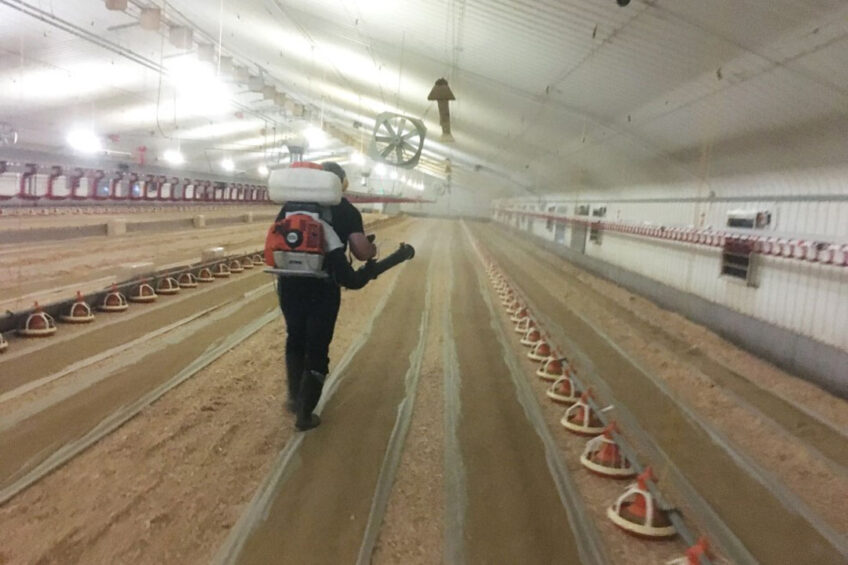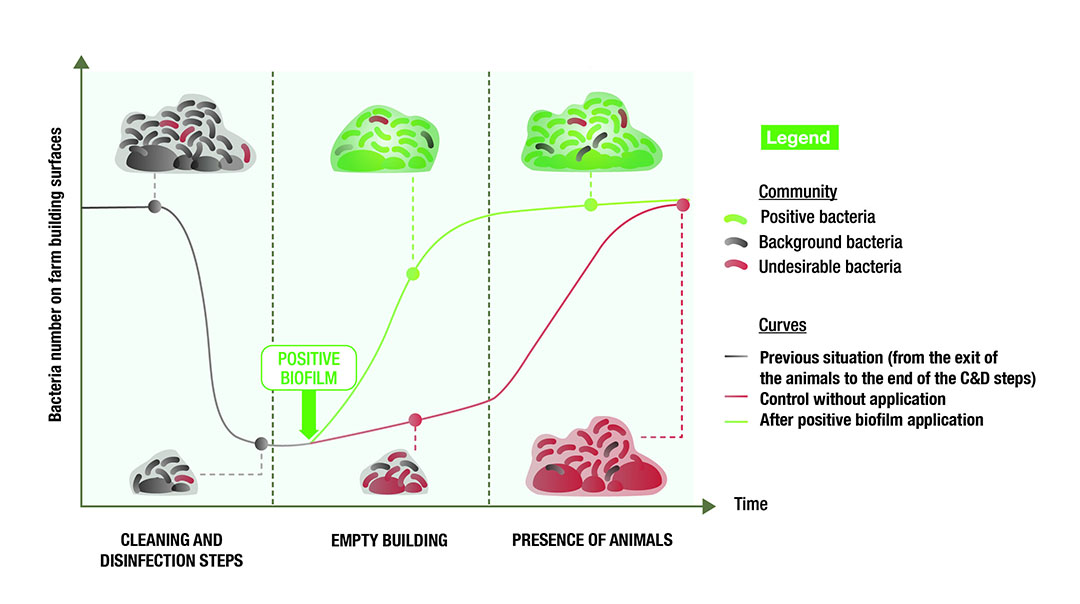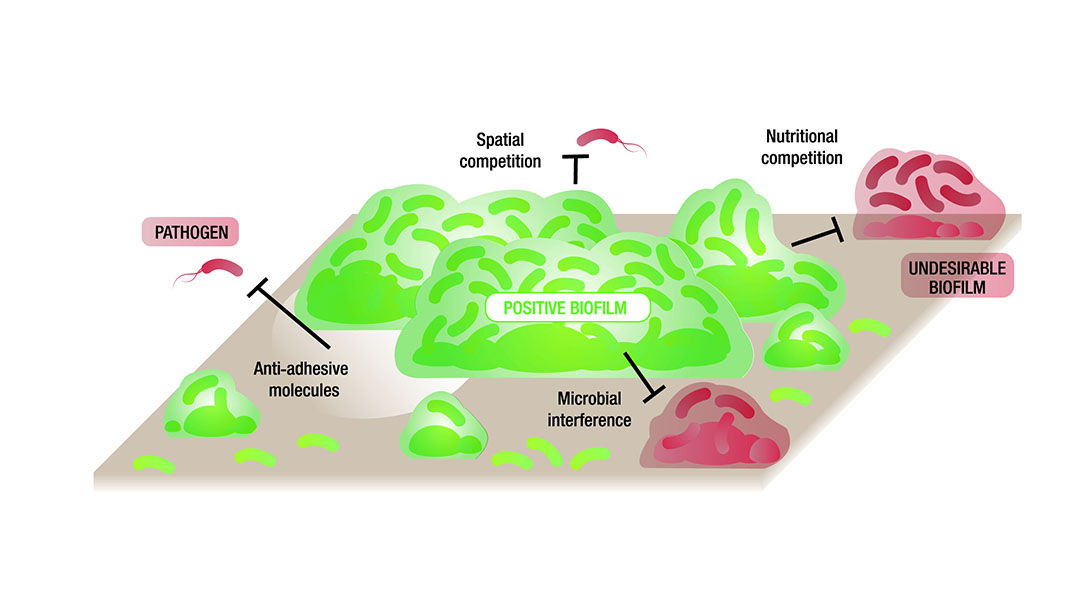Positive biofilms to guide surface microbial ecology

Increasing emphasis is placed on the role and management of microbial biofilms in farm buildings, particularly in the context of reducing on-farm antimicrobial usage while safeguarding the animal microbial environment. A comprehensive review has just been published in the journal Biofilm.
The scientific review provides an overview of the envisioned modes of action of positive biofilms used on livestock building surfaces and the resulting criteria for the selection of the appropriate micro-organisms for this specific application. The authors further discuss the pros and cons of such a biosecurity approach as well as its influence along the food chain, from farm-to-fork.
Biofilms
A biofilm is defined as a “spatially organised community of micro-organisms fixed to a surface”. It represents the most prevalent mode of life for micro-organisms in nature and is omnipresent in all environments. Biofilms secrete a protective extracellular matrix which can represent around 85% of the biofilm biomass. In farm buildings all surfaces – floors, walls, ceilings and equipment – are colonized by biofilms. They can be harmless, positive or negative for the animals if they contain pathogens. Before a new batch of animals enters the building, cleaning and disinfection (C&D) are necessary. However, surfaces do not remain sterile. Micro-organisms carried over from the animal environment and the new animals themselves, quickly start recolonizing the surfaces, forming biofilms again.
The rationale for positive biofilm
Among internal biosecurity measures to limit the persistence and proliferation of pathogenic bacteria in livestock buildings, C&D protocols are applied between each breeding cycle using, for example, biocidal products. However, several studies have shown that such chemicals may not be completely effective against biofilms and only allow elimination of part of the microbiota present on farm building surfaces.
It has been shown in avian farms that C&D protocols are not totally effective in eradicating the residual pathogens responsible for cross-contamination between different batches of animals, such as Salmonella spp., Campylobacter jejuni, Enterococcus spp. and Escherichia coli. This reduction in the efficiency of C&D is directly associated with the formation of biofilms by these surface-associated communities. While various anti-biofilm approaches have been envisaged, none of these biosecurity methods is universal and combined strategies hold the most potential.
A very promising approach appears to be guiding the ecology of a surface by settling positive biofilms that will colonize and physically protect the surface from pathogen multiplication: the positive biofilm strategy (Figure 1). Positive biofilms are already used in many sectors, such as food and healthcare, and show very promising results in farm building applications when used to complement C&D protocols.

How do positive biofilms work?
Four major complementary mechanisms have been described to explain the modes of action of positive biofilms on farm-building surfaces (Figure 2).
1. Anti-adhesive effect: the presence of the positive biofilm itself, or some molecules it produces, can limit the initial adhesion of pathogens on the surface.
2 & 3. Spatial and nutritional competition: by occupying the space and consuming the available nutritional resources, the positive biofilm can limit the proliferation of undesirable bacteria.
4. Microbial interference: through the secretion of specific effectors, such as organic acids or antagonistic molecules, positive biofilms can create an unfavourable environment to help mitigate the presence of undesirable micro-organisms on the surface.

Selecting the best candidate
Advanced screening and metagenomic techniques are used to select the best bacterial strains able to form positive biofilms on farm building surfaces and help keep pathogens at bay. Even where the selection starts in the laboratory, scientists ensure that the bacteria selected are adapted to farm ecobiological and physico-chemical conditions. Most products available on the market are mixtures of lactic acid bacteria (LAB) and Bacillus species. Synergy has been shown between these species. For example, it has been observed that biofilm formed by Bacillus subtilis protects LAB from desiccation.
The application method (spraying) has to be carefully adapted to the selected strains, too. This is all part of the formulation which should be designed to allow optimum adhesion to various surfaces, horizontal and vertical, and ensure early growth of the bacteria (presence of specific nutrients, such as sugar). Finally, the authors indicated that the use of a positive biofilm in farm buildings can have a prolonged beneficial effect beyond building surfaces by reducing the spread of pathogenic organisms and by seeding beneficial bacteria in farm effluents, the environment and the food chain. A valuable tool within a farm-to-fork approach to biosecurity.
On-farm results
Several studies have already demonstrated the benefits of positive biofilms applied to farm buildings. For example, Rodiles and others (2021) reported how an early microbial intervention on building surfaces can influence the microbial communities in a biofilm in a commercial chicken production system. The team used 16S rRNA analysis to identify the biofilm microbial populations. They detected a significant increase and persistence of two genera likely resulting from the contribution of the microbial strains contained in the product (Lalfilm Pro) that was applied. Meanwhile, important families such as Enterococcaceae and Enterobacteriaceae were limited during the first week of rearing. Further data from this study have been submitted to peer-reviewed publications.
References available on request.
 Beheer
Beheer







 WP Admin
WP Admin  Bewerk bericht
Bewerk bericht